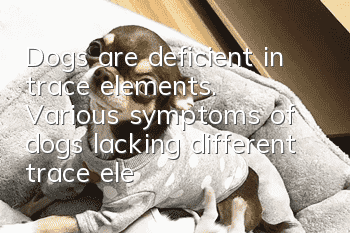Dogs are deficient in trace elements. Various symptoms of dogs lacking different trace elements.

Zinc deficiency in dogs
Zinc deficiency in dogs can cause hair loss, skin redness, inflammation, scabs, parakeratosis and skin ulcers. The main sites of occurrence include lips, toes, foot pads, around the eyes, nose and surroundings, abdomen, other extremities, scrotum and the periphery of the genitals, etc.Factors that may lead to zinc deficiency include:
(1) Insufficient zinc in feed;
(2) Genetic zinc deficiency (such as Alaskan dogs, huskies, Great Danes, etc.) There is a congenital inability to absorb zinc).
(3) The phytic acid content in the feed is high (zinc phytate cannot be utilized by animals);
(4) The calcium content in the feed is high but the zinc content is low;
(5) The feed Excessive copper leads to reduced zinc absorption
VA deficiency in dogs
VA deficiency in dogs can lead to hair loss, rough fur, Sebaceous leakage, hyperkeratosis of epidermal hair follicles, skin scabs, can cause secondary bacterial infection, night blindness, and muscle weakness. In severe cases, it can lead to deafness, otitis externa, paralysis, and other respiratory, digestive, reproductive and urinary system diseases in puppies. In the most serious cases, it can cause resulting in death.Symptoms are most likely to occur on the ventral surface, chest and abdomen.
The causes of VA deficiency are:
(1) VA deficiency in female dogs leads to lack of VA in puppies;
(2) Lack of VA in feed;
(3) Genetic reasons (such as certain some Cocker Spaniels) etc.
Vitamin E deficiency in dogs
Lack of VE can lead to rough and dark coat color, hair loss, wet dermatitis, moderate diarrhea, reproductive failure, muscle weakness, and skin problems in puppies and bitches. Injury, subcutaneous bleeding, etc.The causes of VE deficiency include:
(1) Lack of VE in feed;
(2) Excessive unsaturated fatty acids in feed, leading to VE oxidation.
Vitamin B deficiency in dogs
Niacin deficiency can lead to red lips, traumatic dermatitis (dogs scratch or bite because of itching), etc.
VB2 deficiency can lead to corneal opacity, scaly dermatitis, muscle weakness, scaly dermatitis with erythema on the hind legs, chest and abdomen, watery or pus-like discharge from the eyes, and a staggering gait in severe cases.
Pantothenic acid deficiency can lead to hair loss, hair discoloration (such as black to reddish brown and then to gray), scaly keratosis of soft tissues (such as skin), skin ulcers on the shoulders, neck and back, anemia, diarrhea, gastroenteritis, appetite Poor performance and abnormal walking (may be due to lack of pantothenic acid, which damages nerve function).
VB6 deficiency can lead to skin damage, anemia, growth retardation, neurological abnormalities, reduced antibody production, impaired amino acid transport, endocrinopathy, arteriosclerosis, etc.
Biotin deficiency can lead to hair discoloration, skin damage, skin hyperkeratosis, and poor hair growth.Injury to hoofs and toes, paralysis of hind limbs, and dry secretions around the eyes.
- What do dogs eat to protect their stomach? It is important to protect their stomach and treat gastrointestinal diseases in dogs.
- How to tell if your dog is fat? Is your dog overweight?
- Will your dog catch a cold if you blow the air conditioner? What should you do if your dog catches a cold if you blow the air conditioner?
- What should you pay attention to when your dog drinks water? Don’t be careless when it comes to your dog’s drinking water.
- The dog's mouth bites and shakes. Why does the dog's mouth occasionally shake and bite?
- How to cut a dog's hair? Do you know how to cut a dog's hair correctly?
- Can dogs eat raw eggs? Why can’t dogs eat egg whites?
- Common Dog Problems in Summer How to Deal with Different Dog Problems
- How to keep dogs away from skin diseases. If you do this, will you see if your dog will still be infected with skin diseases?
- What causes anorexia in dogs? Dogs will become anorexic due to lack of exercise. Hounds run at least 5KM every day.



